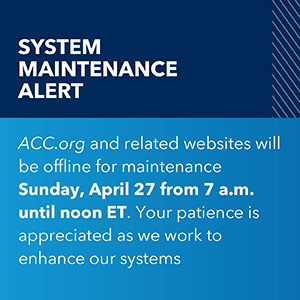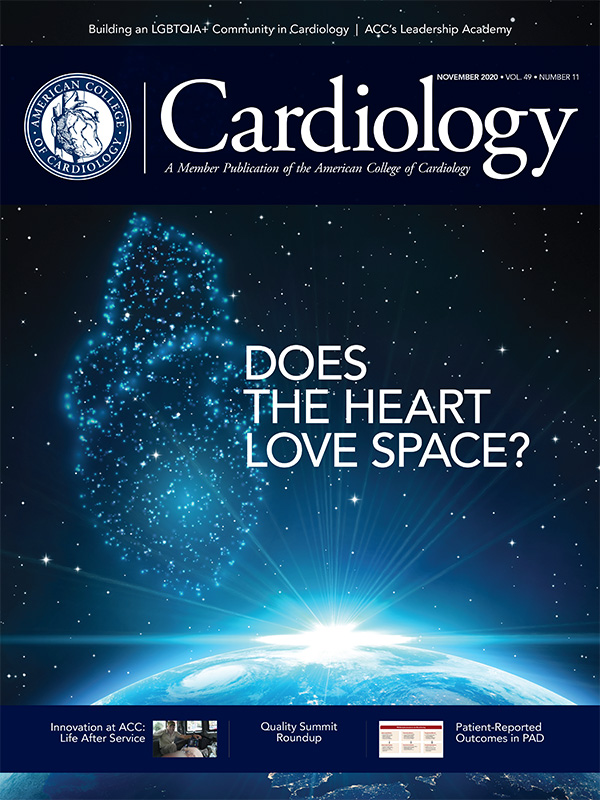Feature | TCT Connect 2020: Interventional Takeaways For My Practice
TCT Connect 2020 delivered a rich meeting across a wide range of topics in interventional cardiology.
Here's my top five takeaways and five quick takes that have brought new insights for my practice.


Takeaway 1: OCT imaging in FFR-negative patients with diabetes improved identification of high-risk lesions and prediction of adverse events.
Coronary physiology and imaging were the focus of the COMBINE (OCT-FFR) trial, which studied 500 patients with diabetes and stable or acute coronary syndromes with coronary lesions that were angiographically intermediate but otherwise nonischemic (fractional flow reserve [FFR]-negative). Optical coherence tomography (OCT) was performed in FFR-negative patients to guide treatment.
Then, patients were divided into two groups based on the presence or absence of OCT-detected thin-cap fibroatheroma (TCFA). After 18 months of follow-up, ≥25% of all FFR-negative lesions were high-risk plaques (OCT-assessed TCFA).
Furthermore, the presence of TCFA was found to be a strong predictor of future major adverse cardiac events (MACE), despite the lack of ischemia. At 18 months, the risk of target-lesion related MACE (and myocardial infarction [MI]) was significantly higher in patients with TCFA vs. those without (hazard ratio [HR], 4.7).
COMBINE (OCT-FFR) showed that even in patients with negative FFR, OCT imaging improved the accuracy of identifying high-risk lesions for further evaluation of vulnerable plaque and improved the accuracy of predicting adverse event outcomes in patients with diabetes.

Takeaway 2: Evaluating residual ischemia post PCI with iFR or FFR may optimize management.
A follow-up analysis from DEFINE-PCI in the roughly one-quarter of patients with hemodynamically significant lesions based on post PCI instantaneous wave-free ratio (iFR) showed greater improvement in anginal symptoms at one year in patients without vs. with residual stenosis.
The iFR value of ≥0.95 was identified as a cutoff for cardiac death or spontaneous MI. After one year of follow-up, despite angiographically successful PCI, patients who were highly symptomatic at baseline without residual ischemia by post-PCI iFR (iFR ≥0.95) tended to have greater improvements in anginal symptoms as assessed by the Seattle Angina Questionnaire compared with patients with residual ischemia (iFR <0.95).
These finding from DEFINE-PCI highlight the importance of performing iFR post intervention and to post dilate or identify other lesions that need to be treated before ending the procedure. Moreover, combining coronary physiology and imaging will provide the best angiographic and physiologic result to patients with angina.
Coronary lesions with an FFR ≤0.80 is an indication for coronary intervention. However, previous studies have found that post-PCI FFR ≥0.90 is associated with a lower risk of repeat PCI and MACE.
This led to the TARGET FFR trial, which studied the application of a physiology-guided incremental optimization strategy to increase the proportion of patients achieving a final post-PCI FFR ≥0.90. This strategy led to an FFR of 0.81-0.89 in 39% of patients and an FFR ≤0.80 in 29%.
The FFR-guided optimization strategy reduced the proportion of patients with a final FFR ≤0.80, however it did not significantly increase the proportion of patients with final FFR ≥0.90.
Results from the TARGET FFR randomized study of physiologic testing with FFR also showed that a suboptimal gain post PCI is not uncommon, and that performing FFR immediately post PCI may help identify and thus manage residual ischemia.

Takeaway 3: Shockwave intravascular lithotripsy (IVL) for severely calcified coronary disease.
Shockwave IVL was examined in the prospective, multicenter, single-arm global DISRUPT CAD III study.
Lesions included in this nonrandomized study were ≥70% and <100% or ≥50% and <70% with positive FFR with severe calcification. Severe calcification was defined as angiographic radio-opacities prior to contrast involving both sides of the arterial wall with total calcium length ≥15 mm, or presence of ≥270° of calcium on at least one cross section by IVUS or OCT.
The primary safety endpoint of freedom from 30-day MACE was seen in 92.2% of the 431 patients from four countries.
There was a low rate of major periprocedural clinical and angiographic complications.
I think this study highlights a few important points: 1) the importance of coronary imaging with IVUS or OCT to evaluate coronary calcification; 2) in patients with severe calcification, Shockwave IVL is effective, safe and easy to use with low complication rates; 3) Shockwave IVL helps dilate calcified lesions and stent delivery; 4) in certain severely calcified and stenotic lesions, atherectomy might be needed to facilitate Shockwave IVL balloon delivery and stenting.
However, as noted by the investigators, future studies are needed that include more complex patients and angiographic lesion subsets to assess the generalizability of these observations, and to clarify the relationships between measures of calcium fracture, stent expansion and long-term clinical outcomes.

Takeaway 4: NACMI Registry has helped to characterize STEMI in patients positive for COVID-19.
In an effort to understand the presentation, management and outcomes of patients presenting with STEMI during this new era of COVID-19, the NACMI (Outcomes From the North American COVID-19 STEMI) Registry has revealed that:
1) STEMI occurred more frequently in Blacks, Hispanics and patients with diabetes; 2) cardiogenic shock (but not cardiac arrest) with a lower left ventricular ejection fraction was the more common presentation in patients positive for COVID-19, and they were also more likely to have atypical symptoms, i.e., shortness of breath and dyspnea; 3) angiography was less likely to be performed (occurred in only 21%) and medical therapy was less likely but 71% received primary PCI (with lytics less likely to be used); 4) rates of in-hospital mortality and in-hospital stroke were higher and the length of stay was longer. The Registry is ongoing and will continue to collect data on COVID-19 patients presenting with STEMI.

Takeaway 5: Paclitaxel drug-coated devices didn't increase mortality after endovascular therapy and adding rivaroxaban improved outcomes.
New data from the VOYAGER PAD trial have shown there was no association between mortality and paclitaxel drug-coated devices (DCD) vs. non-DCDs in patients with peripheral artery disease (PAD) undergoing lower extremity revascularization. More than 1,300 patient underwent DCD implantation and showed no mortality difference vs. those who did not.
Notably, regardless of DCD use, a consistent benefit was achieved with rivaroxaban 2.5 mg twice daily plus aspirin vs. placebo in reducing post revascularization limb and cardiovascular outcomes.
At three years, there was a 2.6% absolute risk reduction in cardiovascular death, acute limb ischemia, major amputation, MI or stroke with rivaroxaban plus aspirin vs. placebo.
The benefit of this regimen appeared to be greater in patients with both PAD and coronary artery disease. TIMI major bleeding and intracranial hemorrhage were similar in both groups.
Based on these findings, it may be beneficial to add rivaroxaban to aspirin after an endovascular intervention, especially in patients who also have diabetes and coronary artery disease.
Moreover, DCD seems to be safe and does not increase risk of mortality in patients with PAD.
Quick Takes From TCT 2020
IVUS guidance, vs. angiographic guidance, was associated with a lower risk of target vessel failure at three years in the ULTIMATE trial of all-comers undergoing second-generation DES implantation.
In the COMPARE CRUSH study, crushed prasugrel compared with integral prasugrel, did not improve TIMI 3 flow at first angiography or complete ST-segment resolution at one hour post PCI; both were administered as a 60 mg load in the ambulance prior to primary PCI in patients with suspected STEMI.
TICO-STEMI found that ticagrelor monotherapy after three months of dual antiplatelet therapy was superior at preventing ischemia and bleeding after PCI for acute coronary syndromes (STEMI, NSTEMI, unstable angina) compared with standard DAPT up to 12 months.
A systematic review of all randomized clinical trials with ≥1,000 patients with STEMI undergoing primary PCI found that bivalirudin, vs. heparin, was associated with lower rates of 30-day mortality, serious bleeding and net adverse clinical events. However, heparin was associated with lower rates of MI and stent thrombosis.
SOLVE-TAVI found the 30-day rates of all-cause mortality, stroke, moderate or severe prosthetic valve regurgitation and permanent pacemaker implantation were similar with both the Edwards Sapien S3 (balloon-expandable) valve and the Medtronic CoreValve Evolut R (self-expandable) valve in symptomatic patients with severe aortic stenosis undergoing transfemoral TAVR.
However, at one year, the rate of stroke was higher with the Sapien 3 vs. the CoreValve Evolut R valve (6.9% vs. 1.0%, respectively), as well as the echo-based mean gradients. No significant differences were seen between patients who received local anesthesia with conscious sedation and those who received general anesthesia.
The MITHRAS study found that routine closure of an iatrogenic atrial septal defect post transcatheter mitral valve repair does not improve 6-minute walk distance or mortality/heart failure hospitalization, compared with conservative management.
IVUS guidance, vs. angiographic guidance, was associated with a lower risk of target vessel failure at three years in the ULTIMATE trial of all-comers undergoing second-generation DES implantation.
In the COMPARE CRUSH study, crushed prasugrel compared with integral prasugrel, did not improve TIMI 3 flow at first angiography or complete ST-segment resolution at one hour post PCI; both were administered as a 60 mg load in the ambulance prior to primary PCI in patients with suspected STEMI.
TICO-STEMI found that ticagrelor monotherapy after three months of dual antiplatelet therapy was superior at preventing ischemia and bleeding after PCI for acute coronary syndromes (STEMI, NSTEMI, unstable angina) compared with standard DAPT up to 12 months.
A systematic review of all randomized clinical trials with ≥1,000 patients with STEMI undergoing primary PCI found that bivalirudin, vs. heparin, was associated with lower rates of 30-day mortality, serious bleeding and net adverse clinical events. However, heparin was associated with lower rates of MI and stent thrombosis.
SOLVE-TAVI found the 30-day rates of all-cause mortality, stroke, moderate or severe prosthetic valve regurgitation and permanent pacemaker implantation were similar with both the Edwards Sapien S3 (balloon-expandable) valve and the Medtronic CoreValve Evolut R (self-expandable) valve in symptomatic patients with severe aortic stenosis undergoing transfemoral TAVR.
However, at one year, the rate of stroke was higher with the Sapien 3 vs. the CoreValve Evolut R valve (6.9% vs. 1.0%, respectively), as well as the echo-based mean gradients. No significant differences were seen between patients who received local anesthesia with conscious sedation and those who received general anesthesia.
The MITHRAS study found that routine closure of an iatrogenic atrial septal defect post transcatheter mitral valve repair does not improve 6-minute walk distance or mortality/heart failure hospitalization, compared with conservative management.
Clinical Topics: Acute Coronary Syndromes, COVID-19 Hub, Heart Failure and Cardiomyopathies, Invasive Cardiovascular Angiography and Intervention, Noninvasive Imaging, Stable Ischemic Heart Disease, Vascular Medicine, Acute Heart Failure, Interventions and ACS, Interventions and Imaging, Interventions and Vascular Medicine, Chronic Angina
Keywords: ACC Publications, Cardiology Magazine, Acute Coronary Syndrome, Tomography, Optical Coherence, Shock, Cardiogenic, ST Elevation Myocardial Infarction, Calcium, Hospital Mortality, Plaque, Atherosclerotic, Constriction, Pathologic, Fractional Flow Reserve, Myocardial, Percutaneous Coronary Intervention, Stroke Volume, Prospective Studies, Follow-Up Studies, COVID-19, Length of Stay



